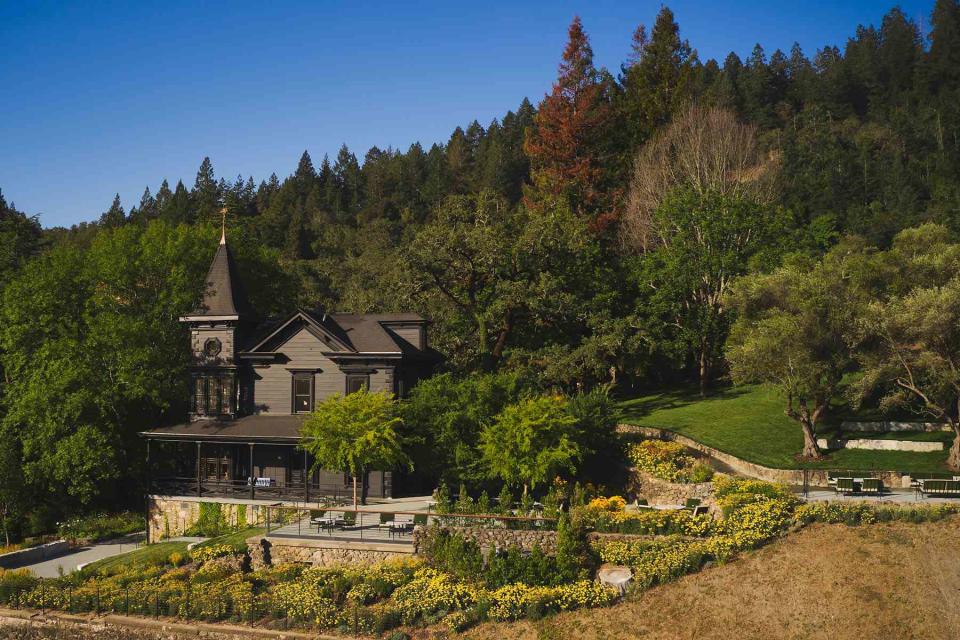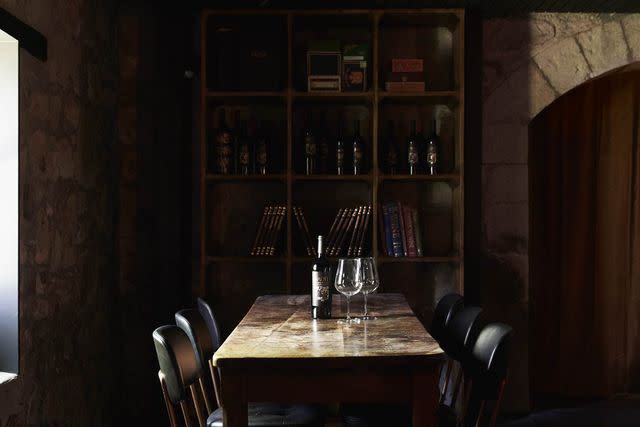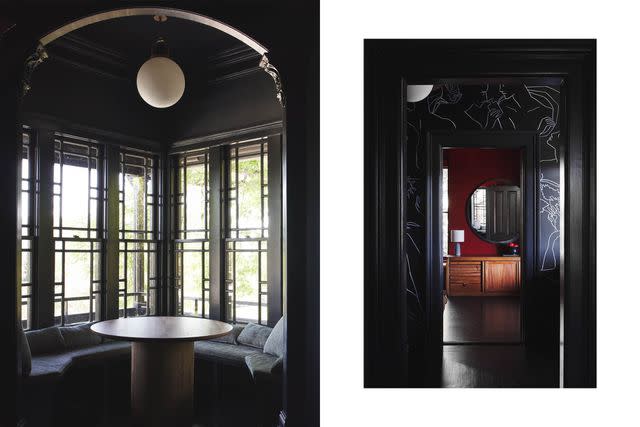Inside Napa Valley's Most Stunning Wine Mansion — and the Chilling Ghost Story Behind It
- Oops!Something went wrong.Please try again later.
The Faust Haus in St. Helena, California, is so much more than just a picturesque spot to sample full-bodied cabs.

Adrian Gaut
The newly unveiled Faust Haus, a Napa Valley tasting room in St. Helena, is a luscious, black-velvet dreamscape at 2867 St. Helena Highway. The historic hilltop home is whimsical in its starkness, unabashedly Gothic and freshly coated in a shade of inky black paint that only a certain kind of house can pull off. It's one that’s seen its fair share of misfortune over the last century or so. But don’t be fooled: despite the mansion’s somewhat eerie history, Faust Haus is one of Napa’s warmest, most welcoming and visually striking places to taste wine, and the spirits rumored to inhabit it only add to its character.
This plot of land, like most around it, was originally home to Indigenous peoples for thousands of years before soldiers and settlers claimed it as their own. According to Napa-based historian and writer Lin Weber, it was the Callejomano nation — part of what we now know as the Wappo nation — who hunted and gathered on these grounds until European forces began to arrive, bringing with them disease and other forms of abuse and demise that decimated the population in the 1830s and beyond. Englishman Edward Turner Bale, a doctor to the Spanish army, married the niece of an important official and was given 17,000 acres of this stolen land in 1841; the couple established a homestead on what is now Whitehall Lane, along with a gristmill near the site where the Faust Haus stands today.

Adrian Gaut
By 1846, the Mexican-American War had begun in Texas and eventually made its way to California, lasting until 1848 — just as the California Gold Rush took hold. Bale was counted among the first to mine the area but suddenly fell ill (some sources say he caught fever while other accounts cite stomach cancer). He died the following year, leaving everything to his wife, María. But because María, now a young widow, struggled to support her family in the years to come, the size of the Bale estate dwindled, and adding insult to injury, a significant portion of the family’s land was swallowed up by squatters as time went on.
María eventually passed on what was left of the estate to her children, one of whom (Carolina) married winemaking pioneer Charles Krug. Their portion of land — approximately 540 acres — entered its viticultural era in 1861. Charles and Carolina Krug ultimately sold it to Frederick Henry “Fritz” Rosenbaum, a stained glass merchant and gold entrepreneur who was also dipping his toes in the wine business. That's when the original Gothic Victorian home, now the Faust Haus, was built in 1878 with improvements and additions made over the following years. At some point during that period, workers are rumored to have hidden bottles of opium in the stone retaining walls.

Adrian Gaut
Rosenbaum and his wife, Johanna, began harvesting riesling and zinfandel in those early years, adding a wine cellar (complete with room for bottling) to the property as yields became more promising. Two of the Rosenbaums’ sons, Fred Jr. and August, joined the family business as winemakers, and all was well — but not for long. About five years into his winemaking career, 23-year-old August became a serious alcoholic and developed conditions like delirium tremens and severe spells of paranoia, which led to his demise. One day in the blistering heat of late summer 1889, August Rosenbaum allegedly disappeared after expressing concern that someone was out to kill him, and despite a thorough canvas of the area and a widespread police bulletin, it took five days to find his decomposing body in the nearby brush, according to Weber’s 2013 book "Prohibition in the Napa Valley: Castles Under Siege."
However, another book entitled "Ghost Hunter's Guide to California's Wine Country," by Jeff Dwyer, claims that August died suddenly inside the house in 1889. Either way, Johanna Rosenbaum died three years later at age 48 due to her grief, and it is said that visitors to the property have experienced ghostly activity. Per the Saint Helena Cemetery Association’s burial registry, Johanna and August are buried there together in Lot 26, but strangely, there’s no record that any other Rosenbaum family members are buried in that cemetery. Further, August’s sister Bertha is said to have been stalked by a “Count Freyenstine,” who apparently attempted to murder her by gunshot inside the house.
In the years following the Lemony Snicket-esque chain of events that plagued the Rosenbaum family, it’s safe to say there was a lot going on in Napa Valley; Phylloxera descended upon more than 90% of Napa’s vines, and Prohibition wreaked further havoc on the local wine industry (and the local red light district, which had been its heyday up until this point). The property changed hands and names over the years and ended up in shambles until about 1962, when it was rescued by real estate entrepreneur Knight Michael Robbins, who restored and later sold it to the Casey family. The Caseys ran it as St. Clement Winery for about a decade until they sold the wine label to iconic Japanese beer company Sapporo. St. Clement changed ownership a few more times until, in 2016, it finally became part of the Huneeus family business and opened its doors in 2020 as Faust Haus.
Up until its newest era, the Rosenbaum mansion’s ghosts have largely been local lore, or at least a fun story to tell wine nerds with a penchant for the paranormal. But when the Faust team was renovating the property, they found a creepy handwritten note taped inside one of the upstairs walls. Inside was a poem signed mad wolf warrior. And below the poem, the scribe has written: Great Light of Jesus Please Shine Down on the Ghosts And Spirits of Edward Bale And August RosenBaum and Johanna RosenBaum and Lead them All in peace.
It’s enough to make the hairs on the back of your neck stand up, and the note leaves you with even more questions than before, namely: Who is Mad Wolf Warrior? We could potentially connect Mad Wolf Warrior with the Wappo nation, although if this were the case, it would be unclear as to why they might seek protection for Bale or the Rosenbaums. It also brings up another question: What if August Rosenbaum wasn’t crazy at all, what if he was just a spiritually connected guy picking up signs from the other side?
What we do know is that Faust Wines existed long before they acquired this (perhaps haunted) house, and that the brand is directly inspired by the legend of Faust, an age-old German folktale of an alchemist and necromancer who supposedly made a pact with the devil in exchange for otherworldly knowledge and power. The Faust narrative and the mystery behind this house seem almost too synergistic to be coincidence. And as with so many other ghost stories, we might never find the real answers. Then again, the Faustian bargain is also mere mythos, so before anyone gets dragged to the fiery pits of hell (or wherever we go after this), we might as well enjoy a great Napa cab to its fullest.
For more Travel & Leisure news, make sure to sign up for our newsletter!
Read the original article on Travel & Leisure.

